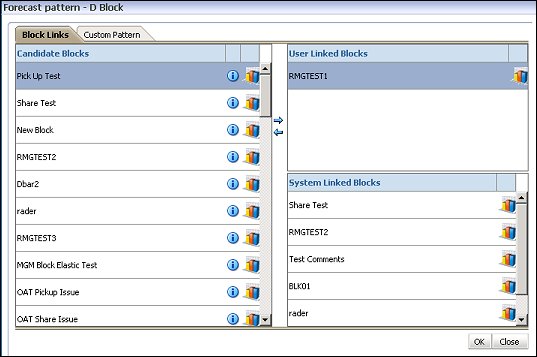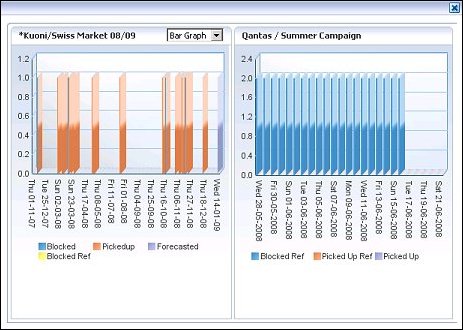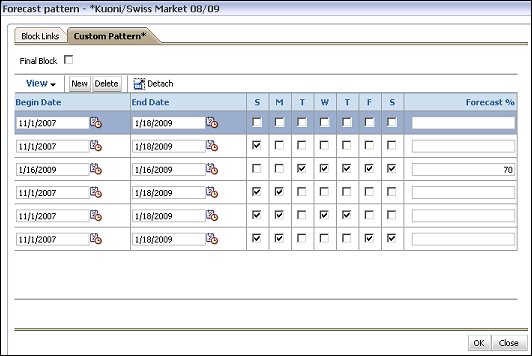
ORMS Blocks
Note: This topic applies to ORMS ADF11.
The Blocks Dashboard displays the groups that have made future reservations at the property for 'block reservations.' You can view block data on various graphs and select filters for report results. Additionally, you can link other blocks to be used as the forecast model for the current block, instead of the ones automatically selected by ORMS. You can also create custom patterns for forecasting the block, if you know the group will have various materialization levels for certain time periods and days of the week during the block reservation. Access the Blocks Dashboard by selecting ORMS > Blocks.
Note: Only Blocks that have a block status configured as Open for Pickup will display by default on this dashboard. To include blocks that currently have a status other than the ones that are Open for Pickup, the user will need to select the Incl. Inactive check box in the Filter section. (The status codes for blocks are defined as Open for Pickup in OPERA Setup > Reservations > Business Blocks > Status Codes; while the status for a specific block reservation is assigned in the OPERA business block header: Reservations > Blocks > Status).
The Graphs section gives a visual depiction of the block rooms for different types of data for the next 14 days (default) or the selected date range from the calendar. The different types of data that can be graphed and selected from the Graph For LOV include:
You may select the type of graph format you want displayed from the Graph Type LOV, either Line Graph or Bar Graph. The default is Line Graph for all blocks of a time span longer than three days. If the block is shorter than three days, the default will be the Bar Graph.
Bar |
Description |
Blue (Blocked rooms) |
Displays current number of "Blocked" rooms on a Master block. You can subtract the Sub-Allocated rooms (yellow column) from the Blocked rooms (blue column) to determine the remaining Unallocated Blocked rooms on the Master block. |
Yellow (Sub-Allocated rooms) |
Displays the number of Sub-Allocated rooms. These are the rooms allocated from the Master Allocation block to a Sub-Allocation block. e.g.) If you have 10 Blocked rooms and allocate 10 rooms to the Sub-block, the grid will then display 10 blocked rooms and 10 Sub-Allocated rooms. |
Red (Picked-up Reservations) |
Displays the reservations picked up from the Sub-Allocated rooms. |
Purple (Forecasted rooms) |
Displays the number of rooms forecasted for the block. |

For details about the Calendar, see Using the Calendar.
Select the criteria you would like displayed on the graph.
Code. Enter the block code to filter the results.
Class. Select the LOV to filter the results by either all Allotment Class Codes (All) or by an individual Allotment Class Code configured for the property.
Type. Select the drop down arrow to select a block type to filter the search results by. The options are: All (both normal blocks and wholesale), Blocks only, or Wholesale only.
Status. Select a reservation status from the multi-select drop down menu to filter the results by selections, such as by All, or Tentative, Definite, Cancel, and so on.
Incl. Inactive. Select this check box to include inactive blocks, as well as blocks that are not Open for Pickup yet.
Incl. Catering Only. Select this check box to only include blocks that are defined as "Catering Only" on the Block Header in OPERA and that have no rooms set up for them.
Reviewed. Select this check box to only view blocks that have been marked as reviewed.
When you see the Expand and Collapse arrows on the dashboard, you can click on the arrow to expand or collapse that area of the screen, respectively.
View. Select View to display options for viewing the Future Blocks grid. Select or deselect the display options according to your preference. Once an item is selected or deselected, the screen will refresh with your selections displayed.
Detach. Select this button to expand the Future Blocks grid you want to view. The expanded view will comprise the entire screen, eliminating other sections, so you can view the current grid singularly.
The Future Blocks grid displays the selections for the date range, filters, and type of block selected from the LOV, either by:

Allotment Code. A system-generated block code consisting of a combination of letters and numbers. The code is a unique sequence of characters identifying the Group Reservation.
Description. Displays a description of the allotment code. By default this description is the name of the Group Reservation.
Forecast Reviewed. (Unchecked by default) Select this check box to mark the block as reviewed. When a user creates a block in PMS, the revenue manager can review the block and select this check box if the block is approved. When the Save button is selected, the block will be marked as reviewed. If changes are made to the block in PMS, this check box will become unchecked thus indicating that the block must be reviewed again by the manager.
Begin Date. Begin date of the group reservation.
End Date. End date of the group reservation.
Duration. Duration of the block in days.
ORMS Block Class. The Allotment Class for the block.
Booking Status. Displays the Block Status of the block.
Wholesale. This is a read-only check box indicating if the block is a Wholesale Block.
Rate Code. Rate code used on the Block Header in OPERA.
Price Range. Price range associated with this block.
Rooms Blocked Per Day. Average number of rooms blocked per day for the duration of the block.
Catering Only YN. This is a read-only check box that when checked, indicates the block is a "Catering Only" block.
Super Block ID. The unique ID for the super block.
Export to Excel. Select this button to export the current data into Excel. Your Internet Explorer needs to be modified to allow this process. If your Network Administrator has not made the global change, see the attached document for instructions on how to modify your Internet Explorer for Export to Excel. Click here.
The grid will be imported with all columns and rows after you select the following prompt, if applicable.
Access this screen by highlighting the desired Block Code and either clicking on the Block Code or selecting the Edit button. The Forecast Pattern displays two tabs: Block Links and Custom Pattern.

This tab contains Candidate Blocks, User Linked Blocks, and System Linked Blocks sections. Linked Blocks are models that will be used for predicting group materialization for the current Block. This grid lets you view graphs and statistics comparing:
Note:
The "Days Delta" value represents the current selected block's number of days minus the selected candidate block's days.
The "Rooms per Day Delta" value represents the current selected block's rooms per day minus the selected candidate block's rooms per day.
Block's days is calculated as (end date - begin date) of the block.
Block's rooms per day is calculated as (greatest number of rooms to sell and number of rooms forecasted to sell) / (block's days).
Note: When a Block has no linked blocks assigned, no Materialization will take place for that block.
Note: When Custom Forecast Patterns are defined for a block, the Linked Blocks functionality is not used for those dates that have been set up with a Custom Forecast Pattern.
These graphs compare the current block with the selected one in the Block Links tab regarding Blocked, Picked Up, and Forecasted.

Note: When Custom Forecast Patterns are defined for a block, the Linked Blocks functionality is not used for those dates that have been set up with a Custom Forecast Pattern.
The custom Forecast Pattern allows the user to define a specific forecast pattern for certain time periods and days of week for a specific block. This comes in handy, for example, when there are convention groups booked. The setup team may arrive for the first and second day, the group contact people arrive as of day 2, the main delegates only as of day 3, and then the setup team arrives again on the second to the last day of the group block. From experience, the Revenue Manager might know that usually about 75% of the Setup team shows up for day 1 and 2. However, only around 65% of the delegates and for the cutback, the team speeds up and tends to finish a day early. Therefore, the last day will only be utilized by approximately 5% of those originally booked. This can all be set up and the forecast will take these patterns into consideration, overruling the pattern given by the linked blocks.

You can edit an existing pattern by selecting it and modifying the dates, days of the week, and forecast percentage.
Final Block. Select this check box to mark the ‘Final Block’ flag on the Block Header in OPERA. (This check box is visible when the OPO_<version number> RMS license code is active and applies to both regular blocks and wholesale blocks. Select this check box to identify this block and its number of rooms actually sold as the number of rooms that ORMS will use for forecasting. This can be calculated before the cutoff date has been reached (see Business Block Rooms Tab) and on the cutoff date. In both cases, the forecasts take into account the rooms actually sold and those rooms that were released to other inventory. If this check box is not selected, then ORMS uses only the original sold block for the forecast and does not include the final amount of actual sold and picked up rooms.)
Begin Date. Enter the start date of the forecast pattern (within the date range of the reservation block).
End Date. Enter the last date of the forecast pattern (within the date range of the reservation block).
DOW. Select the days of the week that will be affected by this pattern.
Forecast %. Enter the percentage of occupancy for the dates and days selected for this forecast pattern.
View. Select View to display options for viewing the Custom Pattern tab. On the list of options, select or deselect the display options according to your preference. Once an item is selected or deselected, the screen will refresh with your selections displayed.
Detach. Select this button to expand the Custom Pattern screen. The expanded view will comprise the entire screen, eliminating other sections, so you can view the current grid singularly.